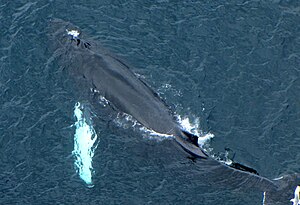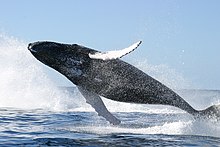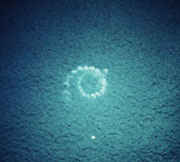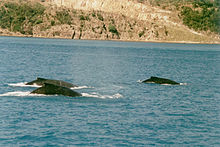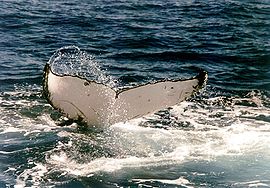Megaptera novaeangliae
Megaptera novaeangliae, also called humpback , gubarte[citation needed] or humpback whale, is a species of mysticete cetacean in the family Balaenopteridae (whales). It is one of the largest fin whales, adults have a length of 12 to 16 m and an approximate weight of 36,000 kg. The species has a distinctive body shape, with long pectoral fins and a gnarled head. It is an acrobatic animal that often propels itself over the surface and then hits the water. The males emit a complex song, which lasts ten to twenty minutes and is repeated for hours at a time. The purpose of the chant is unclear. However, it seems to play a role in mating.
It is distributed throughout all the oceans and seas of the world; they typically migrate up to 25,000 km each year. Humpback whales feed only during the summer in polar regions and migrate to tropical and subtropical waters to breed and give birth during the polar winter. As winter passes, they fast and subsist on their fat reserves. The species feeds mainly on krill and small fish; It has a wide repertoire of feeding methods, including the remarkable technique of bubble netting.
Like other large cetaceans, the humpback whale was hunted. Due to over-harvesting, its population was reduced by 90% before the moratorium implemented in 1966. Since then the population has partially recovered; however, entanglements in fishing gear, collisions with vessels, and noise pollution continue to be a source of concern. A global population of at least 80,000 individuals is estimated. It is currently one of the targets for whale watching, mainly off the coast of Costa Rica where they can be observed 8 months a year (it is commonly said that the "humpback whale season" in Costa Rica is longer than anywhere else in the world,) as well as in Australia, New Zealand, Chile, Ecuador, Colombia, Venezuela, Mexico, Canada, the United States, the Dominican Republic, Peru, and Puerto Rico.
Taxonomy
| Philogenetic tree of cetaceans related to humpback whale | ||||||||||||||||||||||||||||||||||||||||||||||||
|---|---|---|---|---|---|---|---|---|---|---|---|---|---|---|---|---|---|---|---|---|---|---|---|---|---|---|---|---|---|---|---|---|---|---|---|---|---|---|---|---|---|---|---|---|---|---|---|---|
|
Humpback whales belong to the Balaenopteridae (rorqual) family, which includes the blue whale, fin whale, Bryde's whale, northern minke, and minke and minke whales. Whales are thought to have diverged from the other families of the Mysticeti suborder in the mid-Miocene. However, it is not known at what point members of each family diverged from each other.
Despite its close relationship to members of the genus Balaenoptera, the humpback is the only member of its genus since John Edward Gray's publication in 1846. Recent DNA sequence analyzes indicate that the species is more closely related to the gray whale (Eschrichtius robustus) and the fin whale (Balaenoptera physalus) than to other fin whales such as the minke whale (Balaenoptera acutorostra ). If further research confirms this relationship, the fin whales will need to be reclassified.
The humpback was initially mentioned as «baleine de la Nouvelle Angleterre» by Mathurin Jacques Brisson in his work Regnum Animale of 1756. In 1781, Georg Heinrich Borowski described the species, calling it by its equivalent Latin name, Balaena novaeangliae. At the beginning of the XIX century, Lacepède separated it from the family Balaenidae, with the binomial name Balaenoptera jubartes. In 1846, John Edward Gray established the genus Megaptera, with the name Megaptera longpinna for the species, but in 1932 Remington Kellogg returned it to the specific name established by Borowski, novaeangliae.
Etymology
Its common name, jubarta, probably comes from the alteration of the old French name jubartes, which comes from the English word gibbard or from the Latin gibbus, meaning hump.
Humpback whale's other name, humpback whale, derives from the curve in its back that insinuates itself as it submerges. The generic name Megaptera comes from the Greek mega-/μεγα- "big" and ptera/πτερα "fins", in reference to its large pectoral fins. The species name derives from "New Englander", which was probably placed by Brisson because of the regular sightings of humpback whales off the New England coast.
Features
Description
Humpback whales are easily identifiable by their robust build, their long pectoral fins, which reach a third of their body length, and the black coloration of their dorsal region.
The females of the species are larger than the males, making it one of the few mammal species with this characteristic (see sexual dimorphism). The most reliable publication regarding the size of the species dates from 1965, which it was based on thousands of measurements made on animals captured in Australia and Antarctica between 1949 and 1962. The longest animals of each sex measured then were a 14.3m male and a 15.5m female. There is also less reliable record of other measurements in the southern hemisphere that yield data of 17.4 m in a male and 16.2 m in a female, captured in Antarctica between 1934-1935. There are older records, for example one from 1904, which gives a maximum length of 16.2 m for males and 15.7 m for females: however, there is no certainty about the measurement method used. According to the 1965 publication, the size The average length in males was 13 m, while in females it was 13.9 m and in individuals that reached sexual maturity an average of 11.8 and 11.9 m was established for males and females respectively.
The size, shape and proportion of the brain is similar to that observed in other mysticetes; showing some notable differences with respect to toothed cetes in morphology and cell structure. An encephalon obtained from a female had a cerebral mass of 4030 g and a proportionally large cerebellum of 740 g with a percentage of 18% of the total mass. Components of the sense of smell are small or, as is the case with the olfactory lobe, absent, and it is doubtful that they possess a functional sense of smell.
Among the fin whales, the humpback has the thickest layer of skin and subcutaneous fat (called blubber) in proportion to its size; being surpassed only by the blue whale in absolute numbers. The thickness of this layer varies according to the time of year, age and physiological condition.
The pectoral fins are white on the underside and can be white or black on the upper face depending on each population or individual. This area of the fins tends to be white in North Atlantic minnows, while in North Pacific minnows it is often black. The relative size of the pectoral fins compared to other mysticetes is evident. It was found that the length measured from the head of the humerus to the tip of the fin ranges from 28.3 to 34.1 % of the total length of the animal, while in Balaenoptera physalus it only reaches 11.2 to 13.1%, in Balaenoptera musculus from 13.9 to 16.1% and in Eschrichtius robustus from 17.5 to 20.9%.
Body color is black on the back and varies on the belly, where it can be black, white, or mottled. On the head and jaws it presents a series of protrusions typical of the species called tubercles, which are actually hair follicles. The dorsal fin is small and highly variable in shape for each individual; may be almost absent or tall, sickle-shaped. Like other fin whales, humpback whales have a series of ventral folds that start from the tip of the jaw to the umbilical area. The tail, which is frequently taken out of the water at the beginning of each dive, has a unique pattern on its underside that oscillates between black and white; it also has a characteristic saw-like pattern on the trailing edge of the caudal fin.
Each pectoral fin (also with black and white spots and with a drawing specific to each subject) can reach up to a third of the length of the body. This is much more than in any other species in the order cetaceans. To explain this notable difference, several hypotheses have been put forward. It could be an evolutionary advance that ensures greater maneuverability. It could also, thanks to a larger contact surface, improve internal temperature regulation during migrations between cold and tropical areas or be useful, as nets, when hunting in groups to corner fish.
When the humpback emerges, it expels air from its lungs in a cauliflower-shaped cloud up to three meters long. The hot air that comes from the lungs immediately condenses the water vapor it contains on contact with the cold ambient air. The stubby dorsal fin appears out of the water after this geyser and remains visible until the caudal fin emerges. Like other balenopterids, the humpback has between 14 and 22 gular folds, which are actually parallel folds that go from the tip of the mandible to the navel, which expand while feeding, allowing it to considerably increase the volume of the oral cavity. They are less numerous and deeper than those that can be seen, for example, in the blue whale. The characteristic baleen or whales of the suborder are horny productions that filter water while retaining food. The humpback has between 270 and 400 dark-colored beards arranged on each side of the mouth. The females have a lobe (not present in the males) of 15 centimeters in diameter in the genital region that allows differentiating the sexes, since the penis of the males is generally hidden in the genital slit. Females generally give birth every two or three years. Gestation lasts eleven months. It's rare, but certain females can breed two years in a row. The calf measures four to four and a half meters at birth and weighs approximately 700 kilos. It is nursed by its mother for a year, being its only source of food for the first six months. The next six alternate milk with food that they are capable of capturing themselves. The calves leave their mothers at the beginning of their second year, when they reach approximately 9 meters in length. The young reach sexual maturity at five years. They reach adult size soon after. They generally live 40 to 50 years.
Since 1991, the sighting of a white humpback has been reported off the coast of Australia. She was baptized with the name of Migaloo and was mistakenly considered albino for a long time, since she is not without pigmentation in her eyes. It has recently been sighted several times in the company of a juvenile of its species, equally white, which has attracted the attention of the scientific community.
Behavior
Social behavior
Humpback whales live in groups, but usually they are small, unstable groups; the only lasting bonds occur between the mother-infant duo. Groups are most stable in summer, when they cooperate in foraging. Longer lasting relationships of months or years between couples or small groups have been described but very rarely. Their worldwide distribution means that they are seen with other mysticetes or dolphins, but with very few interspecific interactions.
Playback
Humpback whales appear to have a polygamous reproductive mechanism with aggressive competition between males for access to females in heat. The mating season takes place during the summer and takes place in tropical waters.
Sexual maturity is reached between 4 and 6 years (males usually take longer than females to reach sexual maturity). In males, the size of the testicles and spermatogenesis increase during the mating season, coinciding with ovulation in females. In females, after reaching maturity, the size of the ovaries remains constant. As ovulation approaches, the Graafian follicles on the surface of the ovaries enlarge; they generally only ovulate once per mating season. Gestation lasts for 11 to 11.5 months. Mating happens once every two years, but can take place twice in three years.
Of the few observations made during the copulation of the species, it has been observed that the male and female initially swim aligned, after which they intertwine, circling, pairing their pectoral and caudal fins. They then submerge, later emerging vertically with the ventral surfaces joined, before separating and falling into the water each on their own.
Pups are born in tropical and subtropical waters in each hemisphere. Newborns average 4.5 m in length and are nursed by their mothers for up to 12 months, but can begin to feed themselves as early as 6 months. The milk is quite nutritious with a high content of fat, protein, lactose and water, and the young can suck up to 400 liters a day.
Swimming, diving and aerial behavior
Like other members of the Balaenopteridae family, the humpback is a slow swimmer. Speeds have been recorded during migrations from 7.9 to 15.1 km/h; the maximum speed recorded was 27 km/h on an animal injured during a chase.
The frequency and duration of the dives vary according to the time of year. During the summer they usually last less than five minutes and rarely exceed ten minutes. In winter these dives last from ten to fifteen minutes and durations of more than thirty minutes have been recorded.
Food
Humpback whales feed mainly in summer and live off their blubber reserves during winter. They eat rarely and opportunistically during their stay in warm and temperate waters while wintering at the poles. They feed on krill and schools of small fish such as herring (Clupea harengus), salmon (Salmo salar), capelin (Mallotus villosus), (Ammodytes americanus) and others such as mackerel (Scomber scombrus), saithe (Pollachius virens) and haddock (Melanogrammus aeglefinus) in the North Atlantic. In Australian and Antarctic waters, they have been known to feed on krill and copepods. Humpbacks capture their prey either by direct attacks or by stunning their prey by striking the water with their pectoral or caudal fins.
Humpback whales have the most diverse food repertoire of all mysticetes. The most prominent technique is known as "bubble netting", in which a group of individuals swim in concentric circles releasing bubbles from the spiracles under shoals of humpbacks. fish. The ring of bubbles surrounds the school of fish, closing progressively, confining them in an ever smaller cylinder. Then, suddenly, they pounce on them, taking a big bite and swallowing thousands of fish in one gulp. The grooved plates in the animal's mouth allow it to easily drain all the water taken in the maneuver. The ring formed by the bubbles can be up to thirty meters in diameter and requires the cooperation of a dozen animals. Using crittercams) attached to the backs of humpbacks, some individuals were found to release bubbles, others dive deeper to drive fish to the surface, and others pile prey into the net. » through vocalizations.
The humpback whales only natural predators are killer whales. Few observations of attacks have been reported, with more frequent bite marks on the body and fins in many individuals. In regions such as Australia up to 17% of observed individuals of all ages bear scars on their fins; however, only one successful attack on a calf has been observed.
The species has a repertoire of aerial displays, which include jumping over the surface, striking over the water with one or both pectoral fins, and vertical striking of the caudal fin. The purpose of such behavior is unclear, but it is believed to serve multiple purposes ranging from position cues to play.
Song
Both males and females emit vocalizations; however, only males produce the long, loud, complex songs that have made the species popular. Each song is made up of a few sounds in a low register that varies in amplitude and frequency, and usually lasts for ten to twenty minutes. Humpback whales can vocalize continuously for twenty-four hours. They lack vocal cords so they generate sounds by forcing air through their huge nasal cavity.
Individuals within a large area emit the same song. All North Atlantic humpbacks share the same song, different from that emitted by their North Pacific congeners. The song of a town changes slowly over a period of several years without repeating a previous version.
There is no sure explanation of the purpose of the chant. The fact that only males emit it suggests that one of the purposes is to attract the opposite sex. However, in many cases the ones that approach the emitter of the songs are other males, resulting in conflicts; thus, the song could be a challenge directed at other males. Some researchers have proposed that the sounds may have an echolocating function. During the feeding season, humpbacks may emit different vocalizations in unison to gather fish into their nets. of bubbles.
This behavior also occurs in the absence of potential mates. This indicates that it is probably a more general communication tool. It has also been suggested that song is used to keep migrating populations in communication. Some observers have reported that the song begins when the competition for a female ends.
Humpbacks make use of other sounds that they use for social interactions, with sounds similar to grunts, moans, bellows, and barks. Wops are calls between mother and child, and thwops are social calls between unrestrained animals. to the mother-son duo.
Population and distribution
According to the International Union for Conservation of Nature, the world population of humpback whales numbers at least 60,000 animals, with 18,000-20,000 in the North Pacific, about 12,000 in the North Atlantic, and more than 50,000 in the Southern Hemisphere, in any case less than the population calculated before the hunt of 125,000 individuals.
Humpback can be seen in all oceans between latitudes 60ºS to 65ºN. It is a migratory species that spends its summers in the cold waters of high latitudes and breeds in tropical or subtropical climates. They travel distances of more than 25,000 kilometers a year, thus obtaining the record among mammals.
The purpose of the migrations is not known; it may reflect the need to maximize energy gain by exploiting food surpluses during the summer at high latitudes, gaining a thermodynamic advantage by overwintering in temperate or warm waters. The only non-migratory population is that inhabiting the Persian Gulf where the increased availability of food brought in by the monsoon during the summer allows it to remain there year-round. easternmost part of the Mediterranean.
The humpback humpback population seems to reconstitute more easily than that of other mysticete species. The population went from a minimum of 20,000 in the 1966 moratorium to more than 35,000 today. For comparison, the blue whale remained at 5,000 throughout that period[citation required].
The humpback population is estimated to be 12,000 individuals in the North Atlantic Ocean, 7,000 in the North Pacific Ocean, and at least 17,000 individuals in the Southern Hemisphere.
Relations with the human being
Humpback whales have always appeared in sailor's tales. The spectacle of these giant creatures leaping over the water explains much of that attraction. The humpback is probably the origin of the myths of sea monsters and the songs of sirens. Even today, divers who find themselves in the vicinity of singing humpback whales say they feel disoriented, probably due to the force of the notes resonating in their thorax.
Historical Hunting
The species was heavily commercially hunted as part of the whaling industry for many years. During the 20th century, around 200,000 individuals were killed in the Southern Hemisphere. Of this number, about 48,000 were illegally hunted by Soviet whalers. It is estimated that about 28,000 humpback whales were killed in the North Pacific, reducing populations by up to 10%.
As a result of global hunting, up to 90% of individuals in some populations died during the most intense phase of the kill. Despite this, the populations studied appear to be recovering rapidly. The North Atlantic population for 1999 was estimated at 10,400 individuals and the North Pacific at 6,000 to 8,000 animals. The same population for 2008 according to studies carried out in the 2000s, was estimated at a figure of 20,000 individuals.
The hunt was officially terminated in 1966, however the Soviets continued the killing for a few more years. Some hunting by aboriginal populations still takes place in a few sectors and a significant number die due to entanglement in fishing gear and collisions with boats. However, these losses do not have a significant impact on the size of the populations.
Watching tourism
Humpback whales are curious. They spontaneously approach boats and swim around. While this behavior is downright suicide if the ship is a whaler, it makes this species an ideal target for whale watching tourism in various parts of the world since the 1990s. They are very popular, displaying ostentatious behaviors that captivate the public. Like other cetaceans, mothers are generally very protective of their calves and try by all means to get between the calf and the boats. Tour operators were therefore required to follow a code of conduct to avoid unnecessarily burdening mothers.
- Observation sites
- Pacific
In Costa Rica, the whale season runs from July to October for the Patagonian humpback whale and from January to March for the North Pacific humpback whale, reaching the Osa Peninsula where they mate and calve.
In South America, between June and November, they can be seen in Colombia in Bahía Málaga, Gorgona Island and the cove of the Ensenada de Utría National Natural Park. Also on the Ecuadorian coasts of the provinces of Esmeraldas, Manabi and Santa Elena, especially in the vicinity of the Isla de la Plata. In North America they are found off the state of Washington, off New England (Boston), Vancouver Island, and Alaska; They can also be seen on the Mexican coasts of Puerto Vallarta, Jalisco, as well as on those of Nayarit and the Baja California Peninsula, especially between December and March. In Australia they can be seen off the coast of New South Wales and Queensland, with the most frequent sightings off Sydney and in Hervey Bay.
- In the Atlantic
Snaefelsnes Peninsula (western Iceland), Azores Islands (Portugal), Samaná Bay and Banco de la Plata (Dominican Republic) can be seen from January to April, Praia do Forte (Bahia, Brazil) between July and November.
Altruistic behavior
On September 14, 2017, scientist Nan Hauser had a unique experience. For the Brunswick, Ohio-based scientist who has been working with whales for thirty years, it was a typical day in Rarotonga, in the Cook Islands, when a co-worker asked her to take photos of whales for a documentary. She jumped into the sea, saw a large humpback (almost 15 meters) and prepared to take the photos. Suddenly, the big whale swam towards her quickly! Dr. Hauser remembers that she feared for her safety, as she knew that a blow against a fin can be fatal.
For ten long minutes, the whale pushed her constantly, but she didn't know why. Was it an act of aggression? She finally discovered that there was another whale below them. But whales always have tails that move vertically, while this "whale" had a tail that swished from side to side. It was a tiger shark, almost fifteen feet long, and it was swimming toward her. Dr. Hauser was unaware of the shark's motivation; Was it an attack action or just curiosity? However, she thanked the whale and swam towards her ship. From there, she called out to the whale "I love you!"
After the event, Dr. Hauser was confused. Why had a whale saved her? Does it mean that humpback whales have complex feelings like humans? She did some research and found a very similar story: In 2009, a humpback whale saved a Weddell seal in Antarctica. The scientist Robert Pitman watched as the seal lying on an ice floe was harassed by a group of orcas and then a humpback pushed it onto another ice floe. He believed that it had been an act of altruism. Some scientists assume that the only reason for these “altruistic” actions is because humpback whales hate orcas and instinctively save animals that are attacked by them; Some scientists like the idea that whales could have complex thoughts like humans, but there is no way to know their actual thoughts.
Dr. Hauser, though she didn't know why, was glad a whale took ten minutes to help her. Surprisingly, one year and fifteen days later, on September 29, 2018, during another normal day of cetacean research, one humpback in particular suddenly caught her eye. It had a certain white dot on its head and that's how she found out it was last year's whale! Dr. Hauser said, “Hello my friend, you're back! I can not believe it!" She swam with the whale for ten minutes, hugged one of its fins, and again said goodbye. She considers that she is going to see her again and hopes for a new meeting.
Research
Although the anatomy of humpback whales was well known as a result of their hunting, the phenomena of migration and social behavior were not scientifically described until the 1960s by two different studies by R. Chittleborough and W.H. Dawbin.
Roger Payne and Scott McVey studied humpback whales in 1971. Their analysis of songs attracted worldwide media interest, producing a highly intelligent, probably overestimated image of the species in the public. However, this overestimation of intelligence helped the organizations that opposed their hunting.
When scientists realized that caudal fin patterns could serve as a means of identifying individuals, the humpback became the most studied species, as other species had no simple identification system. A study based on data obtained from 1973 to 1988 on specimens from the North Atlantic provided detailed information on gestation, weaning, growth, etc. Thanks to this discovery, it was possible to accurately model the population dynamics of the species as if the mark-recapture technique were used. During this period, a photographic catalog of all humpback whales in the North Atlantic was created, managed by Wheelock College (see here). Other similar projects are being carried out in the North Pacific and in other regions. The website of the organization Greenpeace allows you to follow the position and trajectory of some specimens of this species via satellite on a Google map. The information is offered delayed in time, to prevent the Japanese whaling fleet from using it to hunt them down.
Note
- ↑ In Spanish language, the term “jorobada” is widely used in reference to this species, but it is an inaccurate term since in the field of zoology the term “ballena” only applies to the cetaceans of the Balaenidae family.
Contenido relacionado
Thylacoleo carnifex
Macruronus magellanicus
Ruff
